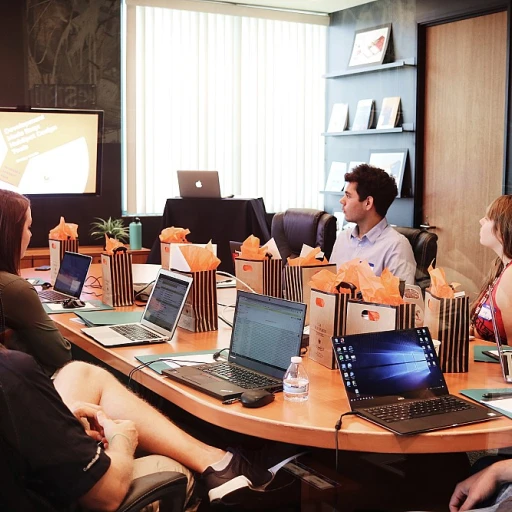
Understanding the Role of Leadership in HRD
The Essential Role of Leadership in Human Resources
Leadership plays a critical role in human resource development, significantly impacting the overall success and effectiveness of an organization. Strong leadership is crucial for creating a productive work environment, ensuring employees are engaged, and facilitating continuous skills development. The role of leadership in human resources extends beyond management tasks to include fostering a culture where growth and innovation thrive.
In a rapidly evolving business landscape, leaders must adapt their strategies to attract and retain top talent, while also nurturing existing employees. This involves viewing human resources as an integral part of overall business strategy, rather than just an administrative function. For instance, the importance of effective leadership in decision making cannot be overstated, as it shapes the workplace culture and influences resource management.
Leadership teams are tasked with creating opportunities for employee development, enhancing both individual and team abilities. As organizations strive to navigate change management and evolve, the focus on leadership development becomes paramount. Skillful leaders recognize the importance of adapting approaches to meet the changing needs of a dynamic workforce.
An excellent example of the transformative power of leadership within HR is succession planning. This strategy not only prepares organizations for leadership transitions but also underscores the value of proactive talent development. For more insights on how succession planning revolutionizes human resources, you can read more in Unlocking the Potential: How Succession Planning Transforms Human Resources.
Ultimately, senior leaders, including the chief people officer, have a responsibility to steer their teams towards success, fostering a collaborative culture that supports the organization's broader objectives. By aligning leadership with human resources functions, organizations can drive more effective outcomes and maintain competitiveness in the marketplace.
Innovative Leadership Strategies
Transformative Approaches for Effective Leadership
In the dynamic realm of human resources, innovative leadership strategies form the backbone of effective management. Today, businesses recognize that strong leadership is paramount to fostering an environment where employees thrive and contribute to organizational growth. Emphasizing innovative approaches ensures that leaders not only manage but inspire their teams.- Cultivating Emotional Intelligence: Emotional intelligence has become a cornerstone of successful leadership. By understanding and managing their emotions, leaders can better navigate complex interpersonal dynamics and drive effective team work. Promoting empathy and active listening among leadership teams enhances their ability to connect with employees, creating a more engaged work environment.
- Agility in Leadership: In the ever-evolving landscape of business, agility is key. Leaders need to be proactive in decision making and responsive to changes within the organization and industry. Agile leadership practices empower leaders to swiftly adapt strategies in response to new challenges, ensuring the continuous development of both the organization and its talent pool.
- Diversity and Inclusion as a Strategy: Fostering a culture of diversity and inclusion within leadership teams not only attracts top talent but also enriches the decision-making process. Diverse teams bring varied perspectives, enhancing creativity and innovation. Utilizing inclusive language in communications further bolsters a sense of belonging and cooperation among employees. Discover more on the power of inclusive language and its impact on HR innovation.
- Encouraging Continuous Learning: An organization that prioritizes continuous learning empowers its leaders to grow alongside their teams. Implementing leadership development programs that focus on both soft and hard skills equips leaders with the tools necessary for effective resource management and strategic foresight. This continuous growth mindset ensures leaders remain proficient in navigating the complexities of human resource management.
Technology's Impact on HR Leadership
Embracing Technological Advancements for Superior HR Leadership
The rapid evolution of technology has undeniably transformed the landscape of human resources leadership. Leaders in human resources are now tasked with effectively integrating technology into human resources practices to not only streamline processes but also enhance the overall work environment and employee engagement. Here are several ways technology is shaping leadership within human resources:- Data-Driven Decision Making: Modern HR leaders utilize data analytics to make informed decisions regarding talent management and development strategies. Data insights enable organizations to identify growth opportunities and improve resource management, enhancing the effectiveness of leadership development programs.
- Enhanced Communication: The advent of digital communication tools has allowed for seamless interaction within leadership teams and between different organizational levels, fostering a more connected workplace culture. A modern intranet, for example, can significantly enhance workplace communication, as highlighted in this link.
- Remote Work and Flexibility: With the need for adaptable work environments, technology plays a vital role in facilitating remote work. Leadership has to adapt strategies to manage teams effectively across different locations, ensuring that employees are supported and engaged no matter where they work.
- Leadership Training and Development: E-learning platforms and virtual training sessions provide scalable leadership development opportunities, allowing leaders to hone their skills and stay abreast of industry trends without geographical limitations.
Building a Culture of Continuous Learning
Fostering a Learning-Oriented Culture
Cultivating an environment that prioritizes continuous learning is essential for the growth and development of both employees and leadership teams. Strong leadership plays a pivotal role in establishing a culture that values knowledge sharing and personal development, ensuring employees feel empowered to expand their skills and contribute to the organization's success. Leaders must adopt effective strategies to integrate learning into the daily workflow, encouraging employees to pursue opportunities for professional enhancement. Creating structured programs for skill development can aid in attracting top talent, as well as retaining valuable team members who are motivated by the potential for growth and advancement. Senior leaders and those in resource management should facilitate access to learning resources, providing a platform where employees can explore various topics relevant to their roles. Encouraging collaboration across teams not only strengthens the organizational structure but also enhances the collective intelligence of the workforce, promoting an innovative mindset. Elements of a Learning-Oriented Culture:- Leadership Commitment: Demonstrating dedication to ongoing education encourages employees to pursue personal and professional development.
- Access to Resources: Equipping the workforce with materials and tools necessary for effective learning enhances their skill set.
- Opportunities for Collaboration: Facilitating inter-departmental projects or initiatives fosters teamwork and knowledge exchange.
- Recognition of Efforts: Acknowledging the achievements of employees in their learning journey boosts their morale and engagement.
Overcoming Challenges in HRD Leadership
Addressing Obstacles in Leadership for HR Development
Creating an effective leadership team within the realm of human resources development involves navigating a myriad of challenges. Recognizing and addressing these obstacles is pivotal to nurturing a thriving work environment and an empowered team.
Resistance to Change: One of the most significant hurdles is overcoming resistance to change. Senior leaders must employ effective leadership strategies to cultivate flexibility and adaptability within their teams. By fostering a culture that values growth and resilience, organizations can better prepare employees to embrace new methods and technologies.
Complex Decision Making: Decision-making processes in HR involve handling diverse and sometimes conflicting interests of a business's multifaceted components. Leaders need to hone their skills to manage resources effectively, ensuring that the organization remains aligned with its goals while addressing employee needs. This necessitates a balance of analytical thinking and empathetic understanding.
Cultivating a Strong Workplace Culture: A robust workplace culture is crucial for attracting and retaining top talent. Leadership teams must work diligently to develop a culture that supports employee development and values diversity and inclusion. By shaping a positive organizational culture, HR leaders can inspire commitment and motivate the workforce.
Developing Continuous Learning Opportunities: Providing opportunities for continuous learning and professional development is essential for building a competent and adaptable workforce. Leadership development initiatives should focus on enhancing skills that are directly applicable to the evolving demands of the organization. Encouraging a learning-oriented mindset ensures that both the leaders and their teams remain equipped for future challenges.
Talent Management and Retention: Efficient talent management involves identifying, developing, and retaining individuals who exhibit potential and contribute to organizational success. By implementing strategies that prioritize the growth and well-being of employees, HR leaders can ensure long-term business success and employee satisfaction.
The role of leadership in human resource management is complex. However, by recognizing these challenges and pursuing actionable strategies, human resources can effectively support their teams and drive impactful change within the organization.












